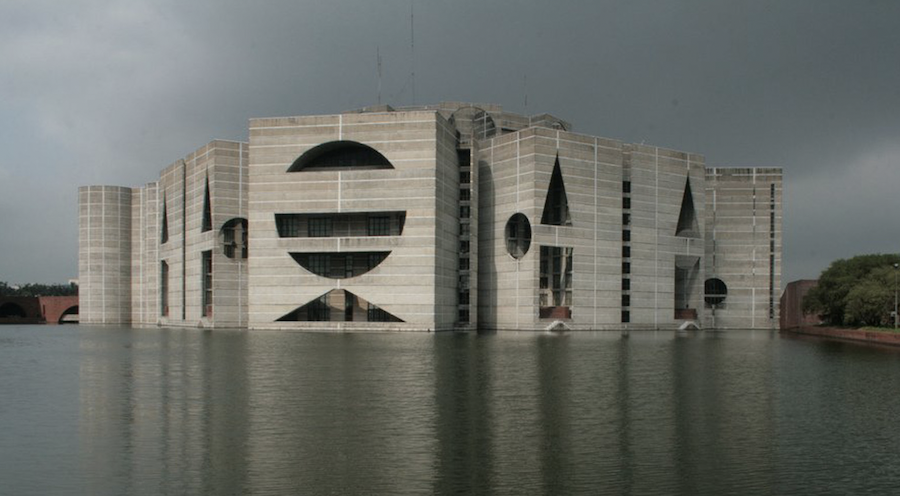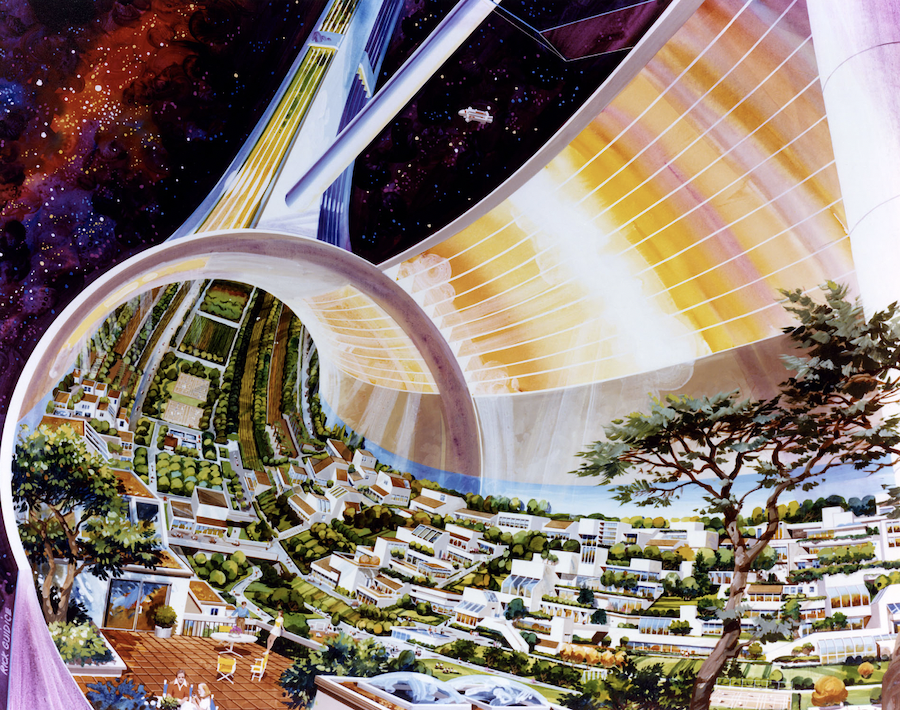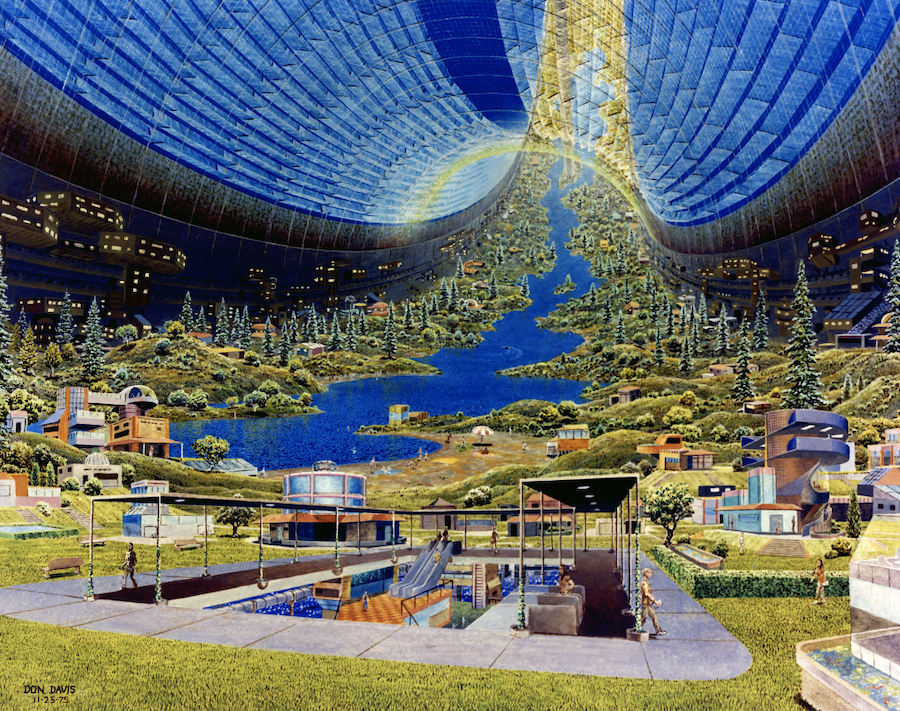Transcending Gravity: The View from Postcolonial Dhaka to Colonies in Space
By Asif SiddiqiOctober 12, 2020
:quality(75)/https%3A%2F%2Fdev.lareviewofbooks.org%2Fwp-content%2Fuploads%2F2020%2F10%2Fspacesettlements.jpg)
Space Settlements by Fred Scharmen

Coincidentally, just at that time, I had bought a cheap paperback from Nilkhet Book Market, a dense shantytown of street vendors in Dhaka where it seemed every Bantam paperback ever produced in the world had somehow ended its journey. The book I bought, The High Frontier: Human Colonies in Space, had piqued my interest mainly for its gorgeous cover: a teeming city with gardens and streets and suburbs on what seemed to be the inside surface of a gigantic circle, floating in outer space as the sun glinted off its metallic outer structure. In the book’s opening pages, its author, Princeton physicist Gerard K. O’Neill, laid out a detailed plan for large-scale human settlements in outer space. His goal was not necessarily to argue for space travel, nor to underscore its benefits, but more to imagine how, once there, we might make a life. The text was embellished by vivid paintings of cities in space, whose form suggested a recursive use of basic geometric shapes, especially the circle. There were spheres, toruses, and cylinders, reminding me of Louis Kahn’s Assembly Building.
For a young boy growing up in a crowded postcolonial city offering little refuge from density, both O’Neill’s space settlement and Kahn’s Assembly Building represented a kind of modernist escape that I couldn’t fully articulate at the time. Both were aspirational, sleek, and committed to their aesthetic. But while the Assembly Building’s otherworldliness was compounded by its being in the middle of Dhaka, O’Neill’s was intensified by the fact that its futuristic gravity-free shapes floating in the cosmos accommodated living spaces within them, full of gentle suburbs, idyllic parks, and mall-like interiors populated by white, well-dressed people who seemed completely content. To me, this was as alien as the cosmos itself. In fact, O’Neill’s space stations united in my young mind the two TV shows that were my sole windows into American culture at the time, Little House on the Prairie and Dallas. These giant cities in space combined the green pastoral landscaping of the former and the cold sterile interiors of the latter. This was an America in space I recognized but could never inhabit.

O’Neill’s vision left an enormous footprint on the Western imagination. His reports, books, and monographs were republished many times, offering tens of thousands of American space enthusiasts a new calling after the Apollo moon landings. In a 1978 review of O’Neill’s work in Physics Today, former NASA astronaut Philip K. Chapman noted that
O’Neill has started a movement in this country and especially on the college campuses, of a magnitude comparable to the ecological or anti-war movements of the 1960’s. His singular achievement is that he has aroused enthusiasm and dedication, not in opposition to some perceived evil or inequity, but in favor of a positive goal: that of human migration into space.
Front and center were the images themselves, evoking a life and place where there was enough space for everyone, and nature and artificiality commingled. This was function over form, vaguely monumental, a liberation from the past and from gravity, all of it mediated through modern technology. It was, in short, a distilled paragon of modernist architecture, or perhaps its last gasp.
Architects have long been entangled in the world of space. In the late 1920s, a young Soviet architectural student, Georgii Krutikov, caused a sensation in the elite architectural institution of the Russian avant-garde, VKhUTEMAS, by proposing, in beautifully rendered drawings and models, a “flying city” (letaiushchego goroda), a living space unmoored from gravity as part of a project on “cities of the future.” Later in the 1960s, Sergei Ozhegov, a leading architect at the Moscow Architectural Institute, created a department to study the architecture of extreme environments, including outer space. Meanwhile, fellow architect Galina Balashova designed the colorful interiors of Soviet-crewed spacecraft such as the Soyuz and Mir space station. In the United States, NASA contracted with the URSAM consortium led by New York architect Max O. Urbahn to design the giant facilities at the Kennedy Space Center in Florida. Later, architect David Nixon, a principal at the UK-based firm Future Systems, worked on NASA’s International Space Station. Already in the 1960s, the architecture profession was making it a priority to grapple with space: in a special issue of Architectural Design from February 1967, bearing a striking cover of a faceless astronaut, artist and “future studies” researcher John McHale and architect Buckminster Fuller meditated on how “outer space” might shift our conceptions of space, interiority, and how to live. In McHale’s view, the impending ecological crisis on Earth could only be solved by a global rather than national movement, one that looked outward into space.
Of all these architectural interventions, O’Neill’s concept of space settlements is most vividly imprinted in the popular imagination, although, paradoxically, while it has generated volumes of literature from historians, few architects have thought critically to inspect his oeuvre. Historians have typically seen O’Neill’s work as either a blueprint for the future of space travel or a manifestation of misguided countercultural effluvium redolent of privilege and fantasy. As W. Patrick McCray has noted in his excellent book, The Visioneers (2012), the dense footprint of O’Neill’s ideas in the United States was in part due to its bringing together establishment figures such as planetary scientist and science popularizer Carl Sagan with post-’60s countercultural luminaries, including Stewart Brand, the figure behind the Whole Earth Catalog, and Timothy Leary, the Harvard-trained evangelist of psychedelic drugs and transhumanist migration into outer space. These public figures were part of an ecology of like-minded thinkers from across the political spectrum who drew strength from the marriage between a broadly environmentally friendly view of the world and techno-utopian ideas about the power of cutting-edge technology.
Fred Scharmen, a professor of architecture at Morgan State University in Maryland, revisits O’Neill in his new book Space Settlements to uncover the web of relationships between the practice of architecture and what he calls “speculative disciplines.” O’Neill’s visions of the built environment in space were, he notes, “part of the lineage of radical images from the 1970s that link the mainstream concerns of these concrete spatial practices with the technosocial speculations of science fiction, technology, politics, apocalypse, and utopia.” There has been a long tradition of architects’ engagement with utopias, both as object of aspiration and subject of critique — they have been rendered, imagined, and obscured by the built environment as part of a general modernist turn in architecture in the first half of the 20th century. A growing cult of technology shaped much of this thinking, and the line between the “manifest” and “speculative” was often a slippery one.
Scharmen recounts the familiar early history of the O’Neill project: an initial meeting funded by Brand in 1974 at Princeton and the subsequent publication of O’Neill’s now-classic paper “The Colonization of Space” in Physics Today later that year. The New York Times covered the meeting, drawing in many fellow travelers to the cause. A larger conference followed in 1975, also at Princeton, and it included many prominent attendees, a “who’s who” of futurists, academics, scientists, politicians, and activists. O’Neill was even called to appear before the House Subcommittee on Space Science and Applications to talk about space settlements. The work spun out in different directions — from creating, for instance, massive solar polar satellites to power space cities, to creating “mass drivers” on the Moon’s surface to launch supplies to the space settlement using electromagnetic principles instead of rockets. The publicity flash was further amplified by the publication of O’Neill’s paperback The High Frontier and the creation of a national mobilizing organization, the L5 Society, named after one of the “Lagrange Points” along the Moon’s orbit where the settlement would maintain itself indefinitely in a tiny orbit.
Scharmen’s focus here is not so much to recreate this cultural topography but to explore what it meant for architects. He wants to find the hidden sinews of a broader genealogy that might account for speculative architecture’s myriad sources. Front and center were the still-mesmerizing paintings by Rick Guidice and Don Davis, which adorned everything associated with O’Neill’s space settlements. Depicting the beautiful Torus Colony, the Bernal Sphere, and the Cylindrical Colony, these paintings have enjoyed a long afterlife, shaping popular expectations of the cosmic future, becoming, as Scharmen notes, “visual hooks for articles on everything from retrofuturism to inclusivity to film theory.”

The paintings, all of which are reproduced in this book — albeit in sizes far too small to convey their wonder — remain striking and, as Scharmen notes, drew from a host of science fiction tropes littered across many novels and pulp stories of the postwar era. They illuminate just how much the disposable culture of science fiction shaped the grand vision of space settlements. O’Neill himself found this connection uncomfortable, refusing to concede that science fiction might have shaped his visions. Scharmen shows they did, suggesting that the way O’Neill’s team “incorporate[d] the space habitats of science fiction into their comparison charts” was itself a form of epistemological “settle[ment]” — of speculative genres “provisionally occup[ying]” architecture.
In the six core chapters of his book, many of them dense with allusions to a vast catalog of Western social theorists, Scharmen is keenly interested in the sources, meanings, and implications of the spatial choices made in the O’Neill settlements. He considers, for example, the ways in which these cities dislodged our normative notions of up and down, and how “out” (away from the center of a torus) and “in” (toward the center) might be better vectors of orientation. In a thoughtful chapter on the discourse of “frontiers,” he builds a case for a different understanding of the space “frontier,” one stemming from anxieties about the “limits of growth,” i.e., the real frontier was not space but the exhaustion of energy and resources on our home planet. Counterintuitively, O’Neill’s approach was not conservation but “to unleash the engines of production and consumption.”
A chapter on the density of social activity on the space settlements is fascinating. Scharmen points out that Carl Sagan, in contrast to O’Neill, found the use of the word “colony” to describe the first space settlements troublesome. Scharmen writes:
Sagan’s proposal to replace colonies with cities presents space as already there for the human user. Cities are dense, where the mental imagery invoked by […] [the] use of colonies is mostly empty. The city dweller that Sagan invokes is cosmopolitan and accepting of difference, whereas the colonist is a separatist, maybe even a xenophobe, and certainly an individualist.
The heuristic of “cities” rather than “colonies” led the designers of the Stanford Torus space settlement to draw their precedent from American cities, and in particular from canonical texts of midcentury American urbanism such as Hans Blumenfeld’s The Modern Metropolis: Its Origins, Growth, Characteristics, and Planning (1967) and Harland Bartholomew’s Land Uses in American Cities (1955). Yet, for all its lip service to a kind of ecological view of urbanism, O’Neill’s designers provided even less per capita open space per person (10 square meters) than actually present in real terrestrial American cities (18 square meters). There was a clear push to minimize, optimize, and standardize.
Scharmen’s text describes several other troublesome aspects of O’Neill’s vision for space settlement. For example, Magoroh Maruyama, a professor at Portland State University, produced a blueprint for incorporating social heterogeneity (“diversity”) through careful planning. His plan, however, reflexively channeled an anti-democratic ethos, with power in the hands of an omnipotent systems designer, a social engineer who would have “an unprecedented degree of social and biological control.” Such a totalizing vision was, in essence, a cosmic culmination of the kind of modernist impulse redolent of Le Corbusier, Robert Moses, and others who merged technocratic visions into aesthetic ones in large-scale midcentury infrastructure projects. This ethos was most evident in O’Neill’s tepid attempts to include humanistic voices in planning these cities. In a follow-on conference in 1985 on “Space Colonization: Technology and the Liberal Arts,” some people talked of the need to frame “space colonization” to reflect societal needs, but even modest suggestions on this front elicited resistance on the part of true believers. A core contributor to O’Neill’s vision, the prolific writer and space evangelist T. A. Heppenheimer wrote:
I want to comment on this famous cliché which we hear so often, “Oh, technology has got such horrible side effects. Technology has been so destructive.” […] We have had people, mostly academics, mostly liberal-arts types, who were envious of the attention paid to their engineering and physicist colleagues, who proceeded to invent, largely out of old cloth, terrible disasters due to nuclear energy. Terrible threats due to waste which you know we could easily dump in the ocean and get rid of it. I think that all of this stuff about the threat of technology, at least 95 percent of it, is nothing more than a put-up job by envious people who resent the attention paid to those who can do rather than merely talk.
This resistance to more egalitarian views was evident when decisions were made about what the population of a city in space should look like. For Carl Sagan in particular, diversity was an explicitly articulated goal. He saw “space cities [as] provid[ing] a kind of America in the skies, an opportunity for affinity groups to develop alternative cultural, social, political, economic, and technological life-styles.” In more ways than one, this “America in the skies” was, in its plans, paintings, and prognostications, a reflection of an imagined white liberal America in space, with its ’60s counterculture affectations wrapped in techno-utopian longing. And as with so many liberal fantasies, there was an expectation of harmony across racial and class boundaries, but no real effort to enact such harmony. Historian of architecture Felicity Scott, who has also written on O’Neill’s space settlements, put it more bluntly: “O’Neill’s promise of a lush, protected suburban lifestyle was code for [the] racial segregation of America.” Scharmen doesn’t pursue this point in depth but it is evident that, barring a few notable examples, O’Neill’s language as well as the associated paintings were clearly coded in terms of a white suburban population sheltered by affluence. Whether O’Neill was aware of it or not, this was very much in contrast to the spatial politics of contemporary movies such as Alien (1979, dir. Ridley Scott) that depicted dilapidated and claustrophobic spaceships ridden with working-class resentment against shady corporate malfeasance. Hollywood, it seems, was already armed with cynicism when technocrats still had their heads in the clouds.
O’Neill’s protestations aside, his project borrowed liberally from utopian and vaguely globalist science fiction — such as Arthur C. Clarke’s Rendezvous with Rama — but could not transcend the American postwar liberal belief in a better world made possible through technology, which ultimately opened the way for its more profitable successor, post–Cold War neoliberalism. Felicity Scott precisely identified this particular strand of his vision as reproducing the American neocolonial ideologies of the day. She argued that, at heart, O’Neill’s project assumed that “what was good for the US was good for the world […] [that through space settlements] the US would be able to supply cheap energy to developing countries or even provide it as humanitarian aid.” But, in fact, O’Neill’s settlement promised not so much a future of plenty on Earth but one where, in her words, Earth “would become the prison for those without the means, education, or work ethic to leave.”
The two words “space” and “settlement” can be juxtaposed to another paired descriptor, “silicon” and “valley.” Both the O’Neill Project and its Earthly sibling, Silicon Valley, see gravity and government, respectively, as enemies of imagination and innovation. Both want to create expert-curated utopias through self-aggrandizing projects with “good” liberal intentions. Like “Silicon Valley,” O’Neill’s architectural vision of lulling cities, controlled environments, and regulated social spaces holds our imagination. That this vision continues to capture the attention of Hollywood is no surprise: those paintings of sunlight gleaming off steel cylinders floating in space are awe-inspiring. But they also continue to appeal to many Americans for another reason: they are monuments to nostalgia for a bygone but idealized modernist America of sterile interiors and green frontiers. Just like I had imagined it many years before as a youth in Dhaka, this was a place where the neoliberal future of Dallas and the settler colonial fantasy of Little House on the Prairie could coexist in perfect harmony. Alien and yet familiar, these cities were as distant from Earth to space as a postcolonial shantytown was to the illusory dream of a future America.
¤
Asif Siddiqi teaches history of science at Fordham University in New York. He has written extensively on the history of space exploration and is currently writing a book, under contract with MIT Press, on the postcolonial history of space exploration as seen through ground infrastructure built around the globe.
LARB Contributor
LARB Staff Recommendations
Gaia Versus the Anthropocene: A Conversation with Dorion Sagan
A celebrated ecological philosopher discusses climate change, the coronavirus, and the powers of the biosphere.
Suicide Missions
Historian Michael D. Gordin reviews several books in order to tackle the problem of deferred solutions — the fact that we seem rigged to defer...
Did you know LARB is a reader-supported nonprofit?
LARB publishes daily without a paywall as part of our mission to make rigorous, incisive, and engaging writing on every aspect of literature, culture, and the arts freely accessible to the public. Help us continue this work with your tax-deductible donation today!